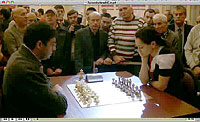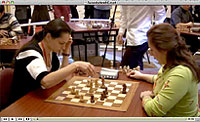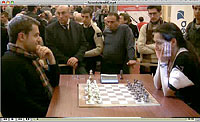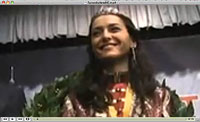Norway Chess Super Tournament 2013 Round 7: Sergey Karjakin in Lead
Chess blog for latest chess news and chess trivia (c) Alexandra Kosteniuk, 2013
Hi everyone,
Round 7 of Norway Chess was another spectacular round, but this time even the venue itself was part of the spectacle. The players were transported by boat to Flor & Fjære, an incredible park at a small island just north of Stavanger, where the audience, press and the players themselves were offered the grand tour and a lovely meal in the restaurant. In the playing hall Svidler and Topalov tried for a world record in exchanging off all the pieces quickly, only to arrive in a pawn ending where the Russian soon squandered his small advantage and a draw was agreed. Wang Hao vs Aronian also drew, without too much ado. Meanwhile, Radjabov butchered his Catalan in surprisingly few moves, and Anand safely converted his advantage. Among the two guys in front, Carlsen seemed to struggle, only to see Hammer fall apart when his opponent got short on time. Hence, Carlsen extended his win streak to 3 games. The tournament leader Karjakin was back on track, deconstructing Nakamura’s Sicilian Najdorf rather convincingly, showing some good technique to clinch the full point in the end. Here is the full report by Hans Arild Runde via the official website.
The first game to finish was Svidler vs Topalov, another Sicilian Moscow variation with 3… Nd7. By move 17 all the pieces except a rook, a knight and a bishop for each side were gone, and by move 23 the players already were in a pawn ending! On the queenside Svidler’s a, b and c-pawns faced two split pawns on a6 and c6, while Topalov had a 4 vs 3 majority on the kingside, with all pawns in their starting positions, except the black pawn on e6. If Svidler would’ve played the very natural 24. b4 immediately, Topalov seemingly would’ve had to tread a bit carefully not to become worse, although the pawn ending looks drawn with accurate play. However, after 24. f4?! c5 25. b4 a5 26. b5 f5! black could easily close the kingside, leaving the white king no possible entry into the black position. This rendered the white protected passer in the b-file quite irrelevant, and a draw was soon agreed.
Radjabov seemingly wanted to get out of the most popular lines in his open Catalan against Anand, playing an early 6. Qa4+ and 7. Qxc4 instead of castling. I’m not certain regarding the relative merits of 8. 0-0 and 8. cxd5, but in my database white does better with the latter and Radjabov went with the former. Both are probably playable. However, after 9. Nc3 Rc8 10. Be3?! white’s position already looks unpleasant after the response 10… b5! played by Anand. After 15 moves the world champion was clearly better, and when he landed his knight on a4 on move 20, white looked locked up and pretty much unable to carry out any active plans. Anand simply increased the pressure, bearing down on white’s cramped pieces, causing immediate crisis when the d-file was forced open on move 25. Black finished things off with some nice tactics when the game was long since lost for Radjabov.
Wang Hao vs Aronian was a rather slow, maneuvering Reti, with only a pair of pawns coming off in the first 17 moves. Aronian’s 17… Qc7?! possibly was a minor inaccuracy, after which a more or less forced series of exchanges left the Chinese with a pleasant position with more space and the bishop pair after 22 moves. The line 23. Rac1 e5 24. Rfd1 Ne6 25. Bb6! would’ve resulted in a slightly cramped position and some problems to solve for Aronian. Instead white’s continuation 23. f4!? e5 24. fxe5 fxe5 25. b3 Ne6 seemingly allowed black to break free. After this lost opportunity for Wang Hao, the game quickly fizzled and a repetition was initiated on move 34.
In the all Norwegian battle of the day, Carlsen chose a careful setup against Hammer’s open Catalan. The players completed their development and reached a fairly balanced middle game. Here Carlsen started to spend a lot of time, apparently struggling to find a good way to play for advantage. Eventually he chose to release the tension in the center by pushing c6-c5, challenging white’s d4-pawn. As early as move 24, black’s time management was slightly worrying for the Carlsen fans, and after 25. Nd4 Hammer’s position looked very comfortable, with nearly 30 minutes on the clock compared to Carlsen’s 3-4 minutes. Whether it was the unusual time situation or something else, Hammer somehow seemed to lose touch with the position at that time, and with 27. Nb5? he made a grave, positional error, offering black a clear advantage. Possibly he missed Carlsen’s 28… Nf6! and from here it quickly went downhill for Norway’s number two. Low on time black may have missed the cleanest execution on a couple occasions, but after move 35 Hammer’s position was hopeless, and when he resigned on move 41, black’s a4-pawn was simply unstoppable.
The last game of the round was leading Karjakin’s fist fight with Nakamura in a Sicilian Najdorf. Karjakin chose the slightly unusual 7. Qe2 after which Nakamura chose to fianchetto his dark squared bishop – a nearly equally rare choice here. These two half-moves brought the game well out of common territory, and after the US number one’s 9… Qa5 we had a position not debated at the elite level before. Black castled short on move 14, with a slightly weakened pawn shelter due to having played 10… h6. Karjakin’s 18. h4 and 19. h5 looked dangerous for black, although Nakamura may still be fine. The first mistake probably was 22… fxg6?! when 22… Rxc3! 23. Qg4 (23. gxf7+ Rxf7 24. Qf2 Rc6) Qxg6 24. Qxg6+ fxg6 25. Rxd6 Rf7 26. Rg1 Nf8 looks sufficient for black. In the game 23. Rxd6 Ne5? was a big blunder that Karjakin could’ve punished even more directly: 24. Qd1! Nc4 25. e5 Qe7 26. Qg4 Kf7 27. Nd4! won material immediately due to the naked black king. 27… Nxd6? 28. exd6 is lost for black.
However, Karjakin kept a big advantage also with 24. Qh1, due to black’s exposed king and weak 7th row. Nakamura’s attempt to defend on the 7th with 28… Rc7?! was busted when white uncorked 29. Nc5! after which black had to give up the queen for rook and knight after 29… Rxc5 30. Rd7 Rc7 31. Rxf7 Kxf7. By this time the position was winning for white, but after a pair of rooks came off on move 35, white had to display some fine technique to demonstrate the win with queen and pawns against rook, knight and pawns, partly due to the nicely placed c4-knight and the slightly awkward white king. This proved no problem for a strong technical player like Karjakin, though, and Nakamura eventually had to resign on move 59.
Hence, after 7 rounds nothing much has changed at the top of the table. Karjakin is still leading half a point ahead of Carlsen, but the gap down from 2nd to Aronian and world champion Anand in shared 3rd has increased to a full point. By now it’s hard to picture any other winner of the event than Karjakin or Carlsen, with their opposition being more or less equally tough in the last two rounds. In shared 5th position we find Nakamura and Svidler, both currently at 50%, while Topalov in 7th at -1 still is hunting his first victory in Norway Chess. Wang Hao and Radjabov share 8th with 2,5 points, while Hammer still struggles in 10th with 1,5 points. Being up against the world champion with black in the next round, it’s certainly a challenge to improve on his current position!
From Alexandra Kosteniuk's
www.chessblog.com
Also see her personal blog at
www.chessqueen.com
Don't miss Chess Queen™
YouTube Channel
Hi everyone,
Round 7 of Norway Chess was another spectacular round, but this time even the venue itself was part of the spectacle. The players were transported by boat to Flor & Fjære, an incredible park at a small island just north of Stavanger, where the audience, press and the players themselves were offered the grand tour and a lovely meal in the restaurant. In the playing hall Svidler and Topalov tried for a world record in exchanging off all the pieces quickly, only to arrive in a pawn ending where the Russian soon squandered his small advantage and a draw was agreed. Wang Hao vs Aronian also drew, without too much ado. Meanwhile, Radjabov butchered his Catalan in surprisingly few moves, and Anand safely converted his advantage. Among the two guys in front, Carlsen seemed to struggle, only to see Hammer fall apart when his opponent got short on time. Hence, Carlsen extended his win streak to 3 games. The tournament leader Karjakin was back on track, deconstructing Nakamura’s Sicilian Najdorf rather convincingly, showing some good technique to clinch the full point in the end. Here is the full report by Hans Arild Runde via the official website.
The view for the players
The first game to finish was Svidler vs Topalov, another Sicilian Moscow variation with 3… Nd7. By move 17 all the pieces except a rook, a knight and a bishop for each side were gone, and by move 23 the players already were in a pawn ending! On the queenside Svidler’s a, b and c-pawns faced two split pawns on a6 and c6, while Topalov had a 4 vs 3 majority on the kingside, with all pawns in their starting positions, except the black pawn on e6. If Svidler would’ve played the very natural 24. b4 immediately, Topalov seemingly would’ve had to tread a bit carefully not to become worse, although the pawn ending looks drawn with accurate play. However, after 24. f4?! c5 25. b4 a5 26. b5 f5! black could easily close the kingside, leaving the white king no possible entry into the black position. This rendered the white protected passer in the b-file quite irrelevant, and a draw was soon agreed.
Radjabov seemingly wanted to get out of the most popular lines in his open Catalan against Anand, playing an early 6. Qa4+ and 7. Qxc4 instead of castling. I’m not certain regarding the relative merits of 8. 0-0 and 8. cxd5, but in my database white does better with the latter and Radjabov went with the former. Both are probably playable. However, after 9. Nc3 Rc8 10. Be3?! white’s position already looks unpleasant after the response 10… b5! played by Anand. After 15 moves the world champion was clearly better, and when he landed his knight on a4 on move 20, white looked locked up and pretty much unable to carry out any active plans. Anand simply increased the pressure, bearing down on white’s cramped pieces, causing immediate crisis when the d-file was forced open on move 25. Black finished things off with some nice tactics when the game was long since lost for Radjabov.
Wang Hao vs Aronian was a rather slow, maneuvering Reti, with only a pair of pawns coming off in the first 17 moves. Aronian’s 17… Qc7?! possibly was a minor inaccuracy, after which a more or less forced series of exchanges left the Chinese with a pleasant position with more space and the bishop pair after 22 moves. The line 23. Rac1 e5 24. Rfd1 Ne6 25. Bb6! would’ve resulted in a slightly cramped position and some problems to solve for Aronian. Instead white’s continuation 23. f4!? e5 24. fxe5 fxe5 25. b3 Ne6 seemingly allowed black to break free. After this lost opportunity for Wang Hao, the game quickly fizzled and a repetition was initiated on move 34.
In the all Norwegian battle of the day, Carlsen chose a careful setup against Hammer’s open Catalan. The players completed their development and reached a fairly balanced middle game. Here Carlsen started to spend a lot of time, apparently struggling to find a good way to play for advantage. Eventually he chose to release the tension in the center by pushing c6-c5, challenging white’s d4-pawn. As early as move 24, black’s time management was slightly worrying for the Carlsen fans, and after 25. Nd4 Hammer’s position looked very comfortable, with nearly 30 minutes on the clock compared to Carlsen’s 3-4 minutes. Whether it was the unusual time situation or something else, Hammer somehow seemed to lose touch with the position at that time, and with 27. Nb5? he made a grave, positional error, offering black a clear advantage. Possibly he missed Carlsen’s 28… Nf6! and from here it quickly went downhill for Norway’s number two. Low on time black may have missed the cleanest execution on a couple occasions, but after move 35 Hammer’s position was hopeless, and when he resigned on move 41, black’s a4-pawn was simply unstoppable.
The last game of the round was leading Karjakin’s fist fight with Nakamura in a Sicilian Najdorf. Karjakin chose the slightly unusual 7. Qe2 after which Nakamura chose to fianchetto his dark squared bishop – a nearly equally rare choice here. These two half-moves brought the game well out of common territory, and after the US number one’s 9… Qa5 we had a position not debated at the elite level before. Black castled short on move 14, with a slightly weakened pawn shelter due to having played 10… h6. Karjakin’s 18. h4 and 19. h5 looked dangerous for black, although Nakamura may still be fine. The first mistake probably was 22… fxg6?! when 22… Rxc3! 23. Qg4 (23. gxf7+ Rxf7 24. Qf2 Rc6) Qxg6 24. Qxg6+ fxg6 25. Rxd6 Rf7 26. Rg1 Nf8 looks sufficient for black. In the game 23. Rxd6 Ne5? was a big blunder that Karjakin could’ve punished even more directly: 24. Qd1! Nc4 25. e5 Qe7 26. Qg4 Kf7 27. Nd4! won material immediately due to the naked black king. 27… Nxd6? 28. exd6 is lost for black.
However, Karjakin kept a big advantage also with 24. Qh1, due to black’s exposed king and weak 7th row. Nakamura’s attempt to defend on the 7th with 28… Rc7?! was busted when white uncorked 29. Nc5! after which black had to give up the queen for rook and knight after 29… Rxc5 30. Rd7 Rc7 31. Rxf7 Kxf7. By this time the position was winning for white, but after a pair of rooks came off on move 35, white had to display some fine technique to demonstrate the win with queen and pawns against rook, knight and pawns, partly due to the nicely placed c4-knight and the slightly awkward white king. This proved no problem for a strong technical player like Karjakin, though, and Nakamura eventually had to resign on move 59.
Hence, after 7 rounds nothing much has changed at the top of the table. Karjakin is still leading half a point ahead of Carlsen, but the gap down from 2nd to Aronian and world champion Anand in shared 3rd has increased to a full point. By now it’s hard to picture any other winner of the event than Karjakin or Carlsen, with their opposition being more or less equally tough in the last two rounds. In shared 5th position we find Nakamura and Svidler, both currently at 50%, while Topalov in 7th at -1 still is hunting his first victory in Norway Chess. Wang Hao and Radjabov share 8th with 2,5 points, while Hammer still struggles in 10th with 1,5 points. Being up against the world champion with black in the next round, it’s certainly a challenge to improve on his current position!
From Alexandra Kosteniuk's
www.chessblog.com
Also see her personal blog at
www.chessqueen.com
Don't miss Chess Queen™
YouTube Channel




































2 Comments:
At May 18, 2013 at 9:25 AM , Jason Bourne said...
Jason Bourne said...
I believe Karjakin will take a clear victory at Norway chess. No tiebreaks.
At May 19, 2013 at 7:55 AM , Amrit Puri, Knights Chess Club, New Delhi said...
Amrit Puri, Knights Chess Club, New Delhi said...
Karjakin as expected
Post a Comment
Note: Only a member of this blog may post a comment.
Subscribe to Post Comments [Atom]
<< Home